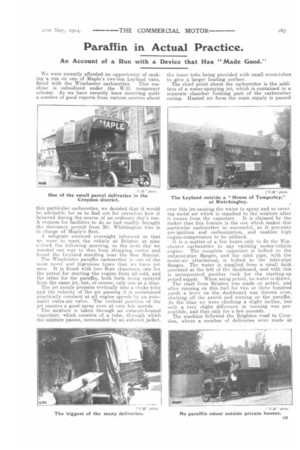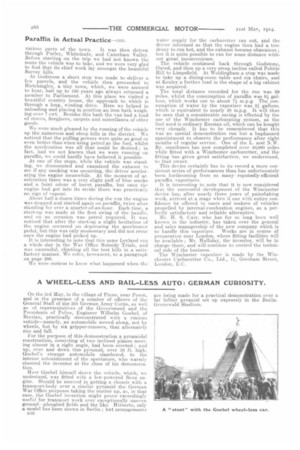Paraffin in Actual Practice.
Page 19

Page 20

If you've noticed an error in this article please click here to report it so we can fix it.
An Account of a Run with a Device that Has "Made Good."
We were recently afforded an opportunity of making a run on cote of Maple's two-ton Leyland vans, fitted with the Winchester carburetter. This machine is subsidized under the W.O. temporary scheme. As we have recently been receiving quite a number of good reports from various sources about
this particular carburetter, we decided that it would be advisable for us to find out for ourselves how it behaved during the course of an ordinary day's run. A request for facilities to do so had readily brought the necessary permit from Mr. Whittington who is in charge of Maple's fleet.
A telegram received overnight informed us that we were to meet the vehicle at Brixton at nine o'cloek the following morning, so the next day we wended our way to that busy shopping centre and found the Leyland standing near the Bon Marche,
The Winchester paraffin carburetter is one of the most novel and ingenious types that we have yet seen. It is fitted with two float chambers, one for the petrol for starting the engine from all-cold, and the other for the paraffin, both fuels being sprayed from the same jet, but, of course, only one ata time. The jet nozzle projects vertically into a choke tube and the velocity of the air passing it is maintained practically constant at all engine speeds by an automatic extra-air valve. The vertical position of the jet ensures a good spray even at very low speeds.
The mixture is taken through an exhaust-heated vaporizer, which consists of a tube, through which the mixture passes, surrounded by an exhaust jacket, the inner tube being provided with small cross-tubes to give a larger heating surface.
The chief point about the carburetter is the addition of a water-spraying jet, which is contained in a separate chamber forming part of the carburetter easing. Heated air from the main supply is passed over this jet causing the water to spray and so creating moist air winch is supplied to the mixture after it comes from the vaporizer. It is claimed by the maker that this feature is the one which makes this particular carburetter so successful, as it prevents pre ignition and carbonization, and enables high engine-compression to be utilized.
It is a matter of a few hours only to fit the Winchester earburetter to any existing motor-vehicle engine. The complete, vaporizer is bolted to the exhaust-pipe flanges, and the inlet pipe, with the moist-air attachment, is bolted to the inlet-pipe flanges. The water is supplied from a small tank provided at the left of the dashboard, and with this is incorporated another tank for the starting up petrol supply. When using petrol, no water is drawn.
The start from Brixton was made on petrol, and after running on this fuel for two or three hundred yards a lever on the dashboard was thrown over, shutting off the petrol and turning on the paraffin. At the time we were climbing a slight incline, but only a very slight difference in running was perceptible, and that only for a few seconds.
The machine followed the Brighton road to Croydon, where a number of deliveries were made at various parts of the town. It, was then driven
through Purley, Whiteleafe, and Caterhain Valley. Before starting on the trip we had not known the route the vehicle was to take, and we were very glad to find that its chief work lay amongst the beautiful Surrey hills.
At Godstone a short stop was made to deliver a few parcels, and the vehicle then proceeded to Bletchingley, a tiny town, which, we were amused to hear, had up to 100 years ago always returned a member to Parliament. At this place we visited a beautiful country house, the approach to which is through a long, winding drive. Here we helped in unloading and placing in position an iron bath weighing over 7 cwt. Besides this bath the van had a load of stoves, fireplaces, carpets and miscellanea of other goods.
We were much pleased by the running of the vehicle up the numerous and steep hills in the district. We noticed that the pulling powers were quite as good or even better than when using petrol as the fuel, whilst the acceleration was all that could be desired ; in fact., had we not known that we were running on paraffin, we could hardly have believed it possible. At one of the stops, while the vehicle was standing, we dismounted and examined the exhaust to see if any smoking was occurring, the driver accelerating the engine meanwhile. At the moment of acceleration there was a. very slight puff of blue smoke and a faint odour of burnt paraffin, but once the engine had got into its stride there was practically no sign of vapour.
About half-a-dozen tunes during the run the engine was stopped and started again on paraffin, twice after standing for over a quarter-of-an-hour. Each time, a start-up was made at the first swing of the handle, and on no occasion was petrol required.. It was noticed that after the start-up a slight hesitation of the engine occurred on depressing the .accelerator pedal, but this was only momentary and did not recur once the engine had picked up.
It is interesting to note that this same Leyland ran a whole day in the War Office Subsidy Trials, and was successful, climbing all the test hills in a satisfactory manner. We refer, hereanent, to a paragraph on page 280. We were curious to know what happened when the water supply for the carburetter ran out, and the driver informed us that the engine then. had a tendency to run hot, and the exhaust became obnoxious ; but it is quite possible to run for some distance without great inconvenience.
The vehicle continued back through Godstone, Oxted, and then up a very steep incline called Pebble Hill to Limpsfield. At W oldinghana a stop was made to take up a dining-room table and .six chairs, and at Kenley a further load in the shape of a big cabinet was acquired.
The total distance recorded for the run was 0 miles, whilst the consumption of paraffin was 9i gadlons, which works out to about 7e m.p.g. The consumption of water by the vaporizer was 21 gallons, which is equivalent to nearly 28 m.p.g. It will thus be seen that a considerable saving is effected by the use of the Winchester carburating system, as the fuel used is ordinary Russian oil, which can be bought very cheaply. It has to be remembered that this. was no special demonstration run but a haphazard appointment to observe the performance after eight. months of regular service. One of the L. and N.W. Ry. omnibuses has now completed over 40,000 miles while fitted with a Winchester carburetter, and the fitting has given great satisfaction, we understand, to that owner.
This device certainly has to its record a more consistent series of performances than has unfortunately been forthcoming from so many reputedly-efficient paraffin vaporizers. It is interesting to note that it is now considered that the successful development of the Winchester device has, after nearly three years of painstaking work, arrived at a stage when it can with entire confidence be offered to users and makers of vehicles propelled by internal-combustion engines, as a perfectly satisfactory and reliable alternative. Mr. H. S. Carr, who has for so long been well known in the industry, has taken over the general and sales managership of the new company which is to handle this vaporizer. Works are in course of preparation near London, where fitting facilities will be available ; Mr. Halliday, the inventor, will be in charge there, arid will continue to control the technical side of the business.
The Winchester vaporizer is made by the Winchester Carburetter Co., Ltd., 11, Gresham Street; London, E.C.


























